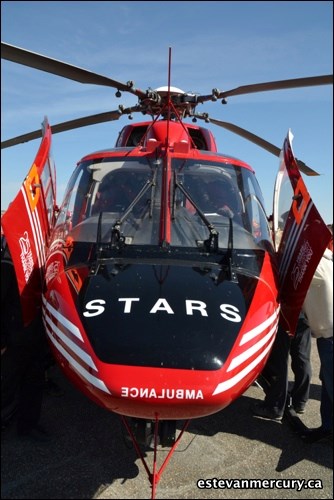Saskatchewan's volunteer firefighters were given a crash course on how to prepare for the addition of the Shock Air Trauma Rescue Society to the province's lifesaving corps Sunday at the Estevan Municipal Airport.
The STARS BK117 helicopter made its arrival in the province Friday night at the organization's facility in Regina. Sunday the aircraft and STARS staff members were in Estevan where they took part in the Saskatchewan Volunteer Firefighter Association's spring fire school, providing landing zone training for the over 200 participants in the event.
"We've given them an understanding of how to access the STARS helicopter, how to land the helicopter when we do arrive on scene and then safety around the helicopter," said Jon Antal, the community education co-ordinator for STARS. "Today, what we are doing is flying the helicopter up, we are doing multiple landing zone training sessions for them so they just get a practical hands-on feel for the helicopter when we do fly out."
Antal added the helicopter's appearance at the SVFFA's spring school was a perfect fit for both groups as they will be working hand in hand once the STARS service begins in Saskatchewan April 30.
"An event like this today is tremendous for us because we get the firefighters trained on how to operate around us and it just makes our job that much easier when we do come out to a scene. We have tremendous support from all the emergency services groups."
Antal said when STARS receives a call, their dispatcher out of Calgary will call ahead to the appropriate group and begin the process of setting up a landing zone wherever they are needed. He added that once a call is received, their goal is to be off the ground in eight to 10 minutes. Their flight time to the scene will obviously depend on location and environmental factors. For instance, Antal noted the trip to Estevan took them 47 minutes.
Due in large part to Saskatchewan's expansive rural population, the addition of the STARS service to the province has been highly anticipated by those in the emergency medical services community.
Captain Phil Hawarth, who has piloting STARS helicopters for six years, said they are excited about providing rapid transport to the citizens of Saskatchewan.
"We are not the be all and end all, we are part of a chain of survival; we provide another link in that chain to provide rapid transport with highly trained medical crew in the back to patients that need it and need to get into that centre of excellence in Regina or Saskatoon or anywhere else in the province."
The arrival of the service carries special meaning for STARS paramedic Shannon Koch. A native of Chaplin, Koch grew up one hour away from the nearest hospital and understands how important every minute can be in a crisis situation.
"It's going to be a real benefit for our health care system to have this in place for rural Saskatchewan," said Koch. "It's exciting to know that you can be part of such a special part of our health care system here and provide that care for people who don't normally have it."
The typical STARS crew will be comprised of two pilots, a paramedic and a nurse. Although the aircraft is a tight fight, they do have room for a physician if one is needed.




